 |
 |
|
 |
Newly reconstructed Hwy 23 brings the world closer to Spicer
|
 |
 |
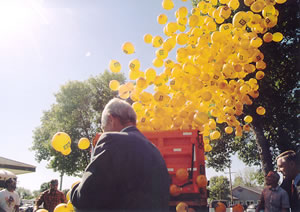 |
| A thousand yellow
balloons imprinted with the Hwy 23 route marker erupted from the bed of
a Mn/DOT snowplow truck at dedication ceremonies for the newly rebuilt
section of the highway. Photo by Craig Wilkins |
Spicer, as they say there, is nicer. The town, midway along a recently rebuilt
section of Hwy 23, is now also closer—closer to Willmar and New London
and especially closer to St. Cloud and Hwy 23’s connection there with
Interstate 94.
That’s closer in the sense of quicker.
Completion of the 11-mile reconstruction project between Willmar and New London
was marked with a community celebration in Spicer’s Saulsbury Beach Park
on Sept. 16.
With a breeze from Green Lake at their backs, a cross section of national,
state and regional leaders hailed the project and the cooperative efforts that
led to its completion.
Mayors, legislators, Southwest Area Transportation Partnership members and
state and federal officials all praised the results the $60 million project
promises to bring.
Lt. Gov./Commissioner Carol Molnau cited Mn/DOT’s efforts to protect
Green Lake and other lakes by working closely with the affected communities.
She also praised the dedication shown by Mn/DOT staff to ensure the project’s
success.
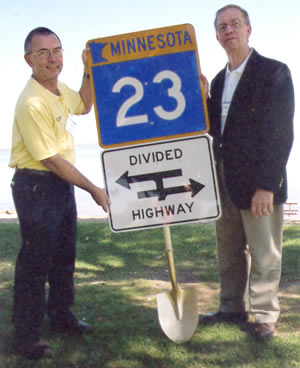 |
Mayor Jeff Thompson of Paynesville (left) accepts the symbolic gold shovel from Willmar/District 8 engineer Dave Trooien. The Paynesville bypass is the next section of Hwy 23 that will be reconstructed. Photo by Craig Wilkins
|
Dave Trooien, Willmar/District 8 engineer, noted the work of the Hwy 23 Task
Force that started in 1995 to document the need for a new highway based on population
growth, the potential for economic development and safety issues associated
with two-lane highways having an excess number of access points combined with
high traffic speeds and rates of growth.
Mayor Bill Taylor of Spicer praised the high level of community participation
in the project that included several task forces and a lot of input from city
leaders.
The newly rebuilt section of Hwy 23 means that about half of the route between
Willmar and I-94 is now a four-lane highway. The next stage of rebuilding Hwy
23 is scheduled to begin in 2009 with construction of a bypass at Paynesville.
Suggestions were heard encouraging a four-lane Hwy 23 corridor from Pipestone
to Hinckley, but the day belonged to the highway’s most recent improvement
and its significance to the region.
“Expansion of Hwy 23 to four lanes will help connect people with jobs,
distributors with manufacturers, shoppers with retailers and tourists with recreation,”
Molnau said. “It will allow Hwy 23 to remain an important interregional
corridor connecting southwestern Minnesota with the St. Cloud area and I-94.”
By Craig Wilkins
|
back

|
 |
Mulvihill selected to lead reorganization of Human Resources |
 |
 |
Susan Mulvihill, Metro District maintenance engineer, this week began a mobility
assignment as interim director of the Office of Human Resources and project
manager for its reorganization.
Mulvihill’s major responsibility is to implement a revised service delivery
model for Mn/DOT’s human resources functions.
She will work with human resources and other functional groups to consolidate
human resource services within the Central Office and define roles and responsibilities
for the Human Resources specialty offices and employee services functions for
the Central Office complex.
Mulvihill will also lead the processes that will identify skills needed to
accomplish objectives, establish an implementation plan to fulfill any gaps
and establish leadership positions and select the most qualified individuals
for them. The appointment is expected to be in effect from four to six months.
The effort will also reinforce the link to customer service that supports the
program delivery operations across the agency.
These changes are a result of a recent study conducted by the Department of
Administration to review the organizational structure, skill sets and customer
service levels of the agency’s human resources functions.
“I look forward to working with the people in human resources, workforce
development and business services to come up with an organization that will
provide excellent customer service,” Mulvihill said. “The talent
of the people in this area will make that task easier to accomplish.”
“Mulvihill’s maintenance experience has provided her with first-hand
experience in labor relations and human resources,” said Kevin Gray, director,
Finance and Administration Division. “Her customer and operational perspective
and demonstrated leadership skills also make her the ideal person to fulfill
this role.”
In addition to this appointment, other Human Resources organizational changes
are being implemented:
· The offices of Human Resource Operations and Workforce Development
will merge as will some functions of the Employee Services Section of the Business
and Support Services Office.
· Rich Peterson, who has been dividing his time between labor relations
and HR operations, will serve fulltime as labor relations director.
· Cathy Walz will continue to provide leadership and coordination of
the agency’s employee development activities.
Employees in the Offices of Human Resource Operations, Workforce Development
and Business and Support Services will continue to report to their current supervisors
until final organizational and leadership decisions are determined.
“I am confident Sue and her team will develop and implement an even more
effective human resources delivery model to meet customer expectations,”
Gray said. “Please give her your support and assistance during this transition.”
By Donna Lindberg
|
back

|
 |
New shared facility at Thief River Falls cuts costs, centralizes operations |
 |
 |
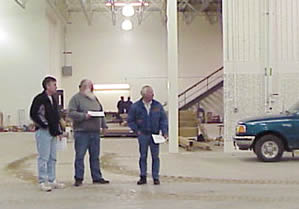 |
|
Inspecting the vehicle maintenance area in the new
Thief River Falls facility are (from left) Tony Bowe, shop supervisor;
Darrel Quick, transportation generalist; and Dave Dalager, district maintenance
superintendent, all with Bemidji/District 2. Photo by Karen Bedeau |
Continuing the trend to consolidate state facilities, Mn/DOT, the departments
of Public Safety and Natural Resources and Pennington County will dedicate a
new government operations center next month near Thief River Falls.
The new $6-million, 65,600-square-foot building was completed in August. It
is located at the junction of Hwy 59 and Hwy 1, just west of Thief River Falls.
The building now houses maintenance crews from Bemidji/District 2 and Pennington
County, regional DNR offices, a substation for the Minnesota State Patrol and
the Driver and Vehicle Services office for the region. The radio maintenance
shop operated by Mn/DOT’s Electronic Communications office also has space
in the new facility, said Ron Lagerquist, an architect with the Facilities Service
Section in the Office of Maintenance.
Next month, the Bemidji/District 2 Resident Office and the bridge maintenance
crew also will move into the new facility.
Co-locating facilities reduces the cost of each agency’s acquiring new
space and enables staff to share their experience and expertise easily and regularly.
It is the seventh such facility Mn/DOT has constructed with other jurisdictions,
Lagerquist said. Other shared sites include Pipestone, Hibbing, Hutchinson,
Moorhead, Glencoe and Duluth.
Additional shared facilities are planned for Ivanhoe, Litchfield and Waseca.
The new facility is designed to support efficient and effective operations,
Lagerquist said.
The site provides covered storage for salt, sand and other highway maintenance
materials that Mn/DOT and Pennington County will share.
The building includes clean, well-lighted work areas for mechanics where the
tools they need to service snowplow trucks and other vehicles are easily at
hand. It also features an indoor truck wash where snowplow operators can quickly
hose away accumulated ice and snow before they return to winter plowing operations.
Extensive use of recycled materials and a passive solar heating system help
lower the building’s fuel costs.
Jim Curran, assistant district engineer for maintenance, said he expects less
tangible benefits from the new facility as well.
“We’re going to share a conference room and a lunchroom,”
he said. “Being on site with the other agencies will give us plenty of
chances to support each other by sharing equipment and ideas and with helping
each other on projects we undertake.”
By Craig Wilkins
|
back

|
 |
Snowplow boot camp prepares operators to meet winter’s challenges |
 |
 |
Mn/DOT begins preparations for the snow and ice season this week with an intense,
two-week snowplow training regimen for plow operators at Camp Ripley, Minn.
Seventy Mn/DOT plow operators gathered at the National Guard training site
near Little Falls for training on plows and other equipment.
The training is intended for new maintenance employees and current employees
whose additional duties may include snowplowing.
According to Rick Shomion, Office of Maintenance, the trainees spend time in
the classroom and on the trucks.
Operators learn the basics of driving and how to operate the various plows and
other equipment on the trucks. They also learn how to inspect the vehicles before
and after operations.
Senior Mn/DOT maintenance staff conduct the training.
“Camp Ripley is a great place to do this training,” Shomion said.
“There is plenty of room. We have several driving courses set up so new
drivers can get experience in the trucks before they take them out on the road
in traffic.”
Shomion said that the training also provides Mn/DOT with a pool of experienced
employees to help meet future training needs.
Training people at Camp Ripley is also more cost-effective than it would be
in the Twin Cities metro area, he said.
“The housing and food costs are very reasonable and the National Guard
is very accommodating and willing to help us,” Shomion said.
To operate a snowplow, a driver must first have a commercial drivers license
(Class B) with an air brake endorsement.
Mn/DOT first trained a small number of snowplow operators at Camp Ripley during
a pilot program held in the spring of 2004. Last fall, more than 100 drivers
completed the training.
Shomion said he expects the training at Camp Ripley will be held each year
due to its cost-effectiveness and its value in producing more confident and
highly trained snowplow operators.
By Kevin Gutknecht
|
back

|
 |
Wikelius accepts post as Mn/DOT’s Drive to Excellence director |
 |
 |
Mark Wikelius, Office of Maintenance director and state maintenance engineer,
was named director of Mn/DOT’s Drive to Excellence program. His appointment
begins Oct. 3.
In his new position, Wikelius will coordinate Mn/DOT’s efforts to meet
the program’s goals to improve government services by taking a more government-wide
approach to information technology, licensing, property management, procurement
and other functions.
The Pawlenty-Molnau Administration created the DTE initiative in 2004 to make
state government more accountable and more efficient.
Wikelius will work closely with the DTE sub-cabinet, the state DTE director
and Mn/DOT’s management team to improve processes such as project coordination,
service level agreements, issues resolution and gathering input for the department’s
focus areas.
Wikelius will report to Kevin Gray, director of the Finance and Administration
Division.
“I look forward to working with Mark in his new role,” Gray said.
“His broad-based operational experience and organizational knowledge will
be great assets to DTE and this agency.”
Mn/DOT’s DTE focus areas include information technology, grant management,
procurement and property management.
Wikelius joined Mn/DOT in 1970. He held several positions in engineering and
management before he was named assistant director of Maintenance in 1995. He
was appointed as director and state maintenance engineer in 1998.
Wikelius’ new office will be located in Room 412 in the Transportation
Building. He may be reached via GroupWise or by phone at 651/282-2273.
Curt Gobeli, who serves as the assistant state maintenance engineer, will serve
as acting director for the Office of Maintenance until a successor to Wikelius
is named. Gobeli held several engineering and management posts before he was
named assistant director in 1998.
|
back

|
 |
State Fair helps Mn/DOT gauge changing public attitudes |
 |
 |
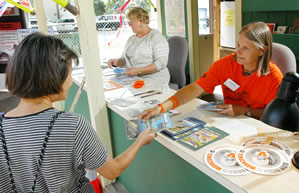 |
|
Lt. Gov./Commissioner Carol Molnau and Donna Karnuth,
Information Technology, staff the Mn/DOT booth at the Minnesota State
Fair. Photo by David Gonzalez |
When it comes to business communications, it’s hard to top a one-on-one
conversation with customers.
Employees from the Minnesota Department of Transportation stepped away from
their regular duties to speak with the people they serve during the recently
completed run of the 2005 Minnesota State Fair.
Thousands of fairgoers visited the Mn/DOT exhibit to learn about the department’s
operations and to share their concerns with the cross-section of employees who
staffed it.
Many visitors offered spontaneous thanks to the department and its people for
their work. Others offered suggestions and/or expressed concerns about Mn/DOT
and its operations in conversations with employees or in the comment cards they
left behind.
“The state fair serves us as a valuable listening post to hear directly
from the people who use our transportation system,” said Lt Gov./Commissioner
Carol Molnau.
“We heard concerns about highway improvements, traffic signal operations,
congestion-related issues and highway signs and road markings,” she said.
Molnau said there was an increase in questions about road striping practices
as Mn/DOT and other agencies use new tactics such as traffic calming, roundabouts
and limited-access freeway lanes.
“The questions and concerns that we heard reflect the increase in traffic
levels statewide and our different responses to them,” Molnau said.
“During the time I spent at Mn/DOT’s booth, I heard a great deal
of valuable feedback about our people and our operations,” Molnau said.
“Whether people compliment us, complain to us or leave a comment card,
the State Fair provides a good indicator of the kind of job we’re doing
for the people we serve.”
By Craig Wilkins
|
back

|
 |
Well-orchestrated response mops up spill in ‘Spaghetti Junction’ |
 |
 |
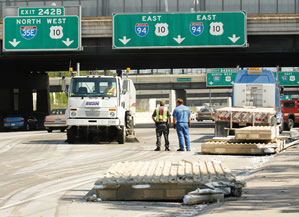 |
|
Pieces of prefabricated concrete walls that spilled
from a flatbed truck block the eastbound lanes of I-94/I-35E near the
Capitol in St. Paul.
Photo by David Gonzalez |
The busy Interstate 35E/I-94 interchange near the Capitol in St. Paul was transformed
on Sept. 8 in mere seconds from a smooth flowing roadway to a nightmare for
motorists when a flatbed trailer flipped, sending its load of prefabricated
concrete walls crashing and sliding into the eastbound lanes.
The 10 a.m. incident blocked two lanes of eastbound I-94 and the ramp from
northbound I-35E. Traffic was backed up for miles on I-94; northbound motorists
on I-35E were diverted to Kellogg Boulevard for hours.
No one was injured in the crash. The incident caused minor damage to the concrete
median barrier and the retaining wall.
While the scene might have looked chaotic at first to motorists, a well-rehearsed
response was underway moments after the crash, said Todd Kramascz, operations
supervisor with Traffic Operations at the Regional Transportation Management
Center in Roseville.
Motorists reported the crash; Jeremy Pratt, a transportation generalist with
the Metro District’s Maryland Avenue truck station, was the first to arrive
on the scene. Additional workers from Maryland Avenue followed and used a front-end
loader to scoop most of the debris back onto the flatbed trailer.
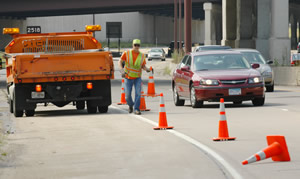 |
A Maryland Avenue truck station worker sets up traffic control in the Interstate 94/I-35E interchange area in St. Paul. Photo by David Gonzalez |
They also used their snowplow trucks to establish initial traffic control.
The State Patrol and Freeway Incident Response Safety Team drivers Larry Potter
and Tony Kasella soon joined them to fully manage the crash scene.
Once the larger pieces of debris were removed, a crew from the Cedar Avenue
truck station used a broom truck to sweep smaller chunks of debris from the
roadway.
“There’s a lot going on at the scene of a crash like this,”
Kramascz said, “but much of the activity is directed from the RTMC.”
He said the State Patrol coordinates the emergency response (fire, ambulance
and hazardous materials) based on reports from the scene. Metro District maintenance
operations dispatches snowplow trucks for traffic control and other equipment
for clean-up work.
Traffic Operations dispatches the FIRST trucks, activates dynamic message signs
to alert motorists, provides updates to the news media and enters data into
the 511 traveler information system.
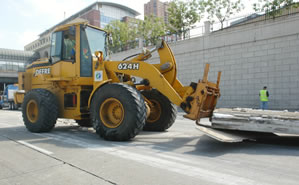 |
A Metro District worker uses a loader to remove large fragments of the spilled load from the roadway. Photo by David Gonzalez |
In short, quick reflexes and resourceful people get it done as fast as possible.
At 2:30 p.m., the scene was cleared and traffic rolled again in the busy interchange.
By Craig Wilkins
|
back

|
 |
|
 |



